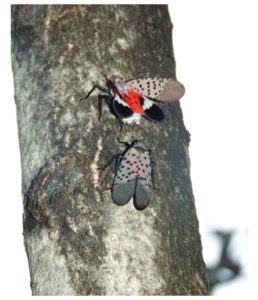Pest Alert: Spotted LanternFly
go.ncsu.edu/readext?645087
en Español / em Português
El inglés es el idioma de control de esta página. En la medida en que haya algún conflicto entre la traducción al inglés y la traducción, el inglés prevalece.
Al hacer clic en el enlace de traducción se activa un servicio de traducción gratuito para convertir la página al español. Al igual que con cualquier traducción por Internet, la conversión no es sensible al contexto y puede que no traduzca el texto en su significado original. NC State Extension no garantiza la exactitud del texto traducido. Por favor, tenga en cuenta que algunas aplicaciones y/o servicios pueden no funcionar como se espera cuando se traducen.
Português
Inglês é o idioma de controle desta página. Na medida que haja algum conflito entre o texto original em Inglês e a tradução, o Inglês prevalece.
Ao clicar no link de tradução, um serviço gratuito de tradução será ativado para converter a página para o Português. Como em qualquer tradução pela internet, a conversão não é sensivel ao contexto e pode não ocorrer a tradução para o significado orginal. O serviço de Extensão da Carolina do Norte (NC State Extension) não garante a exatidão do texto traduzido. Por favor, observe que algumas funções ou serviços podem não funcionar como esperado após a tradução.
English
English is the controlling language of this page. To the extent there is any conflict between the English text and the translation, English controls.
Clicking on the translation link activates a free translation service to convert the page to Spanish. As with any Internet translation, the conversion is not context-sensitive and may not translate the text to its original meaning. NC State Extension does not guarantee the accuracy of the translated text. Please note that some applications and/or services may not function as expected when translated.
Collapse ▲
Image by Richard Gardener, Bugwood CC-BY NC
Although not known to be present yet in North Carolina, a new invasive insect pest known as spotted lanternfly (Lycorma delicatula) has appeared in the Mid-Atlantic states over the past few years. This planthopper native to China is a destructive feeder and prolific breeder that damages both crops and landscape ornamentals.
Spotted lanternfly lays eggs on trees, particularly tree-of-heaven, which ironically is also an invasive species. In addition to tree-of-heaven, spotted lanternfly feeds on fruit trees, grapes, and many hardwood trees. It also has an unusual tendency to lay eggs on outdoor furniture, equipment, and vehicles. Because of this characteristic, there is a high risk that this insect can be unknowingly transported from locations where it is already established, such as Pennsylvania, Delaware, New Jersey, and northern Virginia.
If you visit any of these areas, you may want to take a few extra minutes to inspect the outside of your vehicle before heading home. Look for gray egg masses, which are prevalent from October through June. Even if you aren’t traveling, keep an eye out around your home for spotted lanternfly and alert your county Extension center if you suspect that you’ve seen this pest. Visit NC State Extension’s spotted lanternfly resource page for more information.
— Matt Stevens
Additional interesting articles are available on the Newsletter Index
Extension Gardener Newsletter


